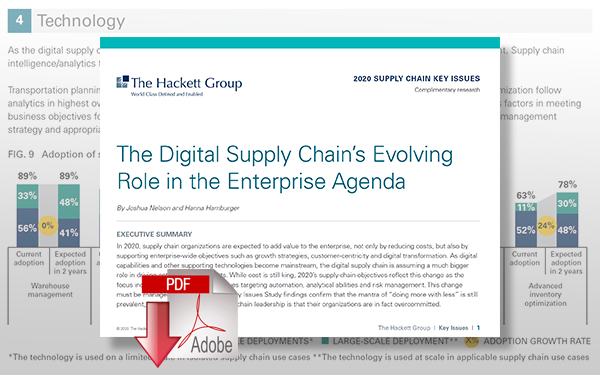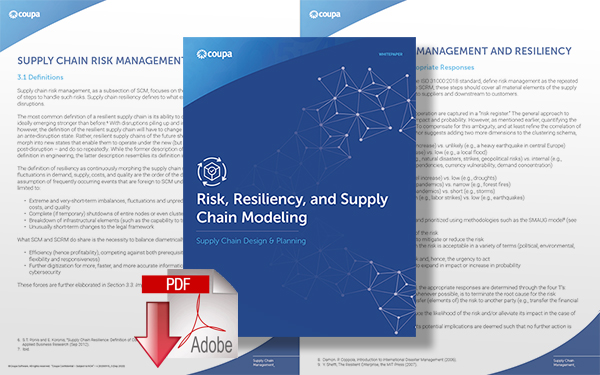Optimizing Supply Chain & Sourcing in Times of Disruption

Creating more holistic supply chain models and seamlessly executing sourcing events allows organizations to improve speed to market, asset utilization, and business value.
Supply Chain Disruptions Continue To Be On the Rise
As organizations strive to reduce costs while increasing speed, the process of procuring materials, making products, and moving them where they need to be is more complex than ever.
In addition to material shortages, labor challenges, and pandemic-related limitations, suppliers and manufacturers are now facing rising costs and bottlenecks in transportation.
In this disruptive environment, organizations must drive collaboration between sourcing and supply chains to align decision-making and secure the transportation capacity they need.
By increasing visibility and sharing information through collaborative technologies, organizations can now optimize supply chain design and sourcing with the resilience they need to face disruptions.
Rising Logistics Costs and Risk in the Supply Chain
Supply chain transportation is becoming increasingly complex, with rising costs and risks along the way. While growth in e-commerce has amplified logistics capacity challenges in the past decade, the pandemic has also led to whirlwinds in demand and capacity. Lockdowns, quarantines, and social distancing hampered production in 2020 while the emergence of the Delta variant extended the pandemic in 2021.
In addition, events like the Suez Canal blockage and the traffic jams at Los Angeles and Long Beach ports have added to the disruption. As a result, organizations have experienced shortages on a level that few ever have.
Compounding the problem is the fact that costs are rising. Shipping rates for a 40-foot container from China to the U.S. east coast reached a record high of $22,000 in September 2021, up nearly 500% from nearly $4,600 a year earlier, according to the Freightos Baltic Index (1). Hong Kong to U.S. air freight rates also reached a high of $9.70 per kilo in September 2021, up 85% from the previous year, according to the Baltic Exchange Air Freight Index (2). Here in the United States, driver shortages are impeding coast-to-coast deliveries and increasing load-to-truck ratios.
For many companies, these challenges are compounded by organizational silos and limited collaboration between supply chain and sourcing. This limits responsiveness and savings potential because while business units may find their savings, they fail to see how their efforts impact the broader supply chain.
Collaboration Is Key to Resilience and Agility
In this current state of constant disruption, organizations need a greater focus on resiliency and agility. We have discovered time and time again that procurement and supply chain are smarter together. By bridging the gap, they can optimize both supply chain design and sourcing to drive greater business value and better equip themselves to manage future disruptions.
This collaboration is especially critical in transportation, where optimization requires strategic input from other business areas, including logistics sourcing. Organizations need to look beyond simply finding the lowest cost solution to ensure suppliers meet critical capacity needs, service levels, and other considerations. These things all need to factor into a supplier's total cost perspective, and ultimately, into the purview of procurement and sourcing.
Aligning decision making and driving collaboration between these two functions can help shorten the time between identifying and securing transportation capacity needs. It can also optimize the transportation routes based on current market information and mitigate risk when accommodating shifting demand patterns. For example, a medical device company overcame COVID disruptions by quickly pivoting to change modes of transportation and unlocking tens of millions of dollars in savings opportunities.
However, one of the greatest impediments to this collaboration is fragmented systems. Many organizations still rely on email, spreadsheets, and phones, which slow down the process and time from decision to execution. This takes longer to identify transportation needs, making it challenging to work together on adjusting transportation modes and mitigating the risk to the fullest ability.
Bridging Supply Chain Design and Sourcing Optimization: Suite Synergy
To enable this collaboration, organizations need technologies that bring together strategic inputs and requirements from procurement and supply chains.
Coupa helps organizations make their supply chains more adaptable and resilient by unifying previously disparate processes across these two business units. Coupa’s Business Spend Management (BSM) platform offers everything organizations need to optimize spending in one place in a scalable, easy-to-use, cloud-native platform. This critical link, known as our Supply Chain Design-to-Source suite synergy, helps bridge our Supply Chain Design & Planning and Sourcing Optimization capabilities to optimize transportation lanes.
Read: Why Procurement and Supply Chain Operations are Smarter Working Together
With this solution, users can optimize the network and capacity model, run sourcing events for identified transportation lanes, and leverage the most current market information to further optimize networks. Creating more holistic supply chain models and seamlessly executing sourcing events allows organizations to improve speed to market, asset utilization, and business value. It offers this while also supporting the resilience and agility required to forge market leadership today and in future disruptions.
In this era of disruption, the only certainty is uncertainty. By fostering collaboration between supply chain and procurement, organizations will be better prepared to respond to whatever is on the horizon.
Sources:
1 “Freightos Baltic Index (FBX): Global Container Freight Index,” Freightos Data.
2 “Baltic Air Freight Indices (BAI): powered by TAC data,” Baltic Exchange.
Related Resources
Digital Supply Chain’s Evolving Role in the Enterprise Agenda
The Hackett Group 2020 Key Issues Study findings confirm that the mantra of “doing more with less” is still prevalent, but the top concern of supply chain leadership is that their organizations are in fact overcommitted, to AI analytics to enable a more agile supply chain. Download Now!
Risk, Resiliency, and Supply Chain Modeling
This paper first examines why existing supply chain management practices do not naturally develop resilient supply chains and why some of the existing supply chain processes are not suitable for addressing such risks and required responses. Download Now!
Continuous Design Outsmarts Disruption: A Blueprint for Supply Chain Resiliency
In this ebook, we discuss how continuous design can reduce risk, improve resilience, and turn supply chain challenges into a competitive advantage. Download Now!
More Resources from Coupa
Related Article: 3 Things Keeping Supply Chain Leaders Up At Night
Article Topics
Coupa News & Resources
How Microsoft Improved ESG & Sustainable Spending Working Together with Community.ai Capabilities Supply Chain Agility in an Ever-Changing World How Sourcing Can Respond in Dynamic Markets to Drive Supply Chain Value Build Resilience in Supply Chains by Modeling & Designing Multiple Demand Futures Beyond Disruptions: Building the Next Generation of Resilient Supply Chains 6 Truths About Business Spend Management Technology 5 Ways Supply Chains Can Flourish in an Inflationary World More CoupaLatest in Supply Chain
Trucking Industry Pushes Back on Government’s Electric Mandates Senators Take Aim at Amazon with Warehouse Worker Protection Act Maersk Sees Silver Lining in Red Sea Shipping Challenges Happy Returns Partners With Shein and Forever 21 to Simplify Returns Baltimore Opens 45-Foot Deep Channel Following Bridge Collapse El Paso Border Delays Cost Juarez $32 Million Per Day in Economic Losses Ranking the World’s 10 Biggest Supply Chains More Supply Chain

















